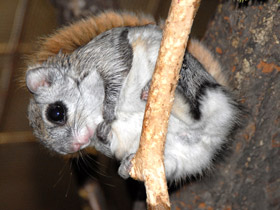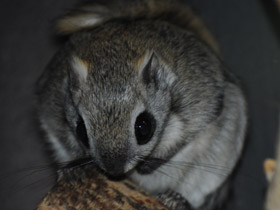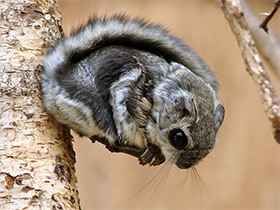The Siberian flying squirrel (Pteromys volans)
The Siberian flying squirrel (Pteromys volans) is an Old World flying squirrel ranging from the Baltic Sea in the west, throughout Northern Asia to the coast of the Pacific Ocean in the east. It is the only species of flying squirrel in Europe and is considered vulnerable in the European Union where it occurs only in Estonia and Finland. In Latvia, it was last sighted in 2001 and has been considered to be locally extinct since 2013.
Habitat, lifestyle and behaviour
Pteromys volans is similar in appearance to a small short-eared squirrel, but between the front and hind legs it has a wide skin fold covered with wool - the webbing, which acts as a parachute. From the front, it is supported by a long bone running from the wrist, which is approximately the same length as the forearm. The animal spends most of its time in trees, coming down even less frequently than the common squirrel. It is not easy to spot Pteromys volans, which is facilitated by its dark grey with brown spots. Spreading its front legs, the animal jumps from the very top of the tree and flies parabolically, travelling up to 50 metres through the air. And in order to be back on the tree, the squirrel performs another acrobatic number in the air: it becomes upright in flight and jumps on the tree with four paws at once. The tail of Pteromys volans is long, covered with thick long hair, with its help it can manoeuvre in the air, making steep turns, turning at right angles.
What do flying squirrels eat
The animal spends the whole day in the hollow of a tree or a nest made of moss and lichen, and only at nightfall leaves it in search of food. Pteromys volans eats birch, alder and hazel earrings, buds of many species of trees and shrubs, young needles, lichens, berries, fruits, nuts with thin shells, such as pine nuts, and nibbles thin young bark. It has one or two broods of 2-5 cubs per summer. Naked and blind, they awaken at half a month of age. Pteromys volans does not hibernate, but is less active in winter.
Predators
The squirrels are preyed upon by martens, hawks, owls, dogs and cats.
In human culture
It is the emblem of Nuuksio National Park in Espoo municipality of Finland due to the density of the population in this region.
In Estonia, the Siberian flying squirrel is depicted on the logo of the Estonian Nature Fund.
Threats
In Finland and especially the Baltic states, the Siberian flying squirrel has been at risk potentially becoming an endangered species. Pteromys volans is already extirpated from Lithuania. Since 1996, it was also considered extinct in Belarus, until being spotted again in 2017, with more than 80 habitats subsequently discovered in far northern regions of the country in 2019. Acts that are believed to be contributors to the decrease in the population size are habitat fragmentation, climate, and habitat loss in places they reside like boreal forests and old-spruce-dominated forests. Because Finland is a member of the European Union, the squirrel is under the protection of the EU's 1992 Habitats Directive. The EU, Finland and Estonia have responded with a six-year, 8.9 million euro project to help protect the squirrel.
















































